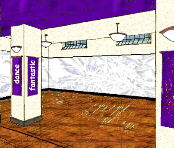AFRICAN-AMERICAN
Compiled from "Image of Perfection:
|
||
Swing Dance In the late 1920s, an important change in popular music occured. Jazz inspired songs replaced the white standards of tin pan alley, and America accepted jazz music as its own. Black musicians like James Mundy, Billy Strayhorn, Benny Carter, and Don Redman began to compose and arrange for white big bands. Margaret Batiuchuk, in her thesis "The Lindy," states that Louis Armstrong was influential in creating "swing music" when he took the New Orleans style of group improvisation and changed it to a solo improvisation over an ensemble group. The result was a style of jazz music that emphasized African influenced rhythm, played strongly and forcefully by a big band. The infectious quality of the swinging rhythm led ballroom dancers to experiment with new patterns of movement. The heightened syncopation in the rhythm appeared in dancers' faster and sharper footwork, and an invigorating "swing bounce" was added to the feeling. The basis for this partner dance was the Texas Tommy , and a combination of the Two-Step and the Charleston known as the Lindy, it was christened when Charles Lindbergh made his solo transatlantic flight in 1927. By the mid-1930s, the Lindy was the rage - first in Harlem's Savoy Ballroom and later in watered down versions in white ballrooms. The Lindy is significant for being the basis for the jazz dance styles used in theatrical productions of the later 1930s, the 1940s, and the 1950s. Choreographers sampled the dancers' syncopated footwork, the feeling of dancing in a crouch (in plie), and the manipulation of tension and relaxation found in the way Lindy dancers would partner each other. Another source of movement was the improvised "breakaway," where for a few bars the partners would release hands and invent individual motions based on vernacular social dances like the Susie Q, the Shorty George, and Truckin'. Finally, the Lindy gave white theatrical choreographers the opportunity to experience and assimilate the African concept of swing. Americans flocked to jazz dance, while American music rapidly transformed from tin pan alley standards to jazz and swing music. Although the masses were dancing in ballrooms and living rooms to the bands of Duke Ellington and Paul Whiteman, jazz dance as a formal means of expression was discredited by the artistic establishment. Ruth St. Denis felt that jazz dance was vulgar, and John Martin, dance critic of the New York Times, stated in 1929 that "The jazz dance is coarse and its purpose crude; its effect is upon the senses, not upon the emotions or intellect. Such is obviously not the stuff of which concerts are made". Jazz dance in its natural form was not of use to the artistic establishment as a means for choreography. Jazz music and jazz dancing waned in popularity during the post-WWII period as the American society slowly changed. The final blow to jazz dance as an active popular entertainment came with the continual evolution of jazz music and technology. Swing music of the 1930s displayed an infectious and consistent beat that encouraged movement by its listeners. The advent of be-bop jazz in the 1940s changed this basic tenet. The beat became rhythmically more complex as musicians like Charlie Parker and Dizzy Gillespie explored more improvisation and less melody. The overall result was that jazz music became something to listen to rather than something to dance to in a social environment. Other reasons for the demise of ballrooms include the smaller size of be-bop combos as opposed to the orchestras of swing music, and a new federal tax on dance floors. In "No Cover Charge," Robert Sylvester elaborates on the devastating effect that this 20% tax had: For some reason, this tax was so rigid that it penalizes a place with entertainment while exempting a place which offers only music. Thus the jazz joints merely dispensed with their dance floors and offered only music. The advent of television in the 1950s was also important in keeping people at home instead of in the dance halls. The American public abandoned jazz dancing as a form of social dance as new music and new ways of living emerged.
|
||
|
